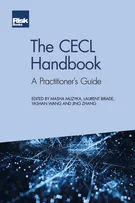The debt and equity linkage and the valuation of credit derivatives
Sean C Keenan, Jorge R Sobehart and Terry L Benzschawel
Introduction
Credit derivatives: the past, the present and the future
The determinants of credit spread returns
What’s driving the default swap basis?
What is the value of modified restructuring?
The debt and equity linkage and the valuation of credit derivatives
Nth to default swaps and notes: all about default correlation
Portfolio credit risk models
Credit derivatives as an efficient way of transitioning to optimal portfolios
Overview of the CDO market
Synthetic securitisation and structured portfolio credit derivatives
Integrating credit derivatives and securitisation technology: the collateralised synthetic obligation
Considerations for dynamic and static, cash and synthetic collateralised debt obligations
CDOs of CDOs: art eating itself?
Valuation and risk analysis of synthetic collateralised debt obligations: a copula function approach
Extreme events and multi-name credit derivatives
Reduced-form models: curve construction and the pricing of credit swaps, options and hybrids
Dynamite dynamics
Modelling and hedging of default risk
ISDA’s role in the credit derivatives marketplace
Credit linked notes
Using guarantees and credit derivatives to reduce credit risk capital requirements under the New Basel Capital Accord
In their seminal article, Modigliani and Miller (1958) presented a theory that became a cornerstone of modern finance. Their paper explained the indeterminacy of corporate capital structure under certain idealised conditions. Several of these conditions are simplifying assumptions that could easily be relaxed. But crucial to their analysis is the assumption of complete contingent claims markets. Under these conditions, both investors and managers are indifferent as to whether firms finance projects using debt or equity, and projects expected to add value to future states of the world will be financed by one means or the other. All claims are contingent in a probabilistic sense, and corporate default risk is efficiently priced through consensus expectations about the relative likelihood of future states of the world.22See Arrow (1964). Credit derivatives per se are unnecessary in this scenario, since each investor creates a portfolio of contingent claims diversified over all possible future world conditions. In simple terms, each investor holds a portfolio of assets, with each portfolio’s return tied to the returns for all projects, in some specific future state of the world.
While
Copyright Infopro Digital Limited. All rights reserved.
You may share this content using our article tools. Printing this content is for the sole use of the Authorised User (named subscriber), as outlined in our terms and conditions - https://www.infopro-insight.com/terms-conditions/insight-subscriptions/
If you would like to purchase additional rights please email info@risk.net
Copyright Infopro Digital Limited. All rights reserved.
You may share this content using our article tools. Copying this content is for the sole use of the Authorised User (named subscriber), as outlined in our terms and conditions - https://www.infopro-insight.com/terms-conditions/insight-subscriptions/
If you would like to purchase additional rights please email info@risk.net






